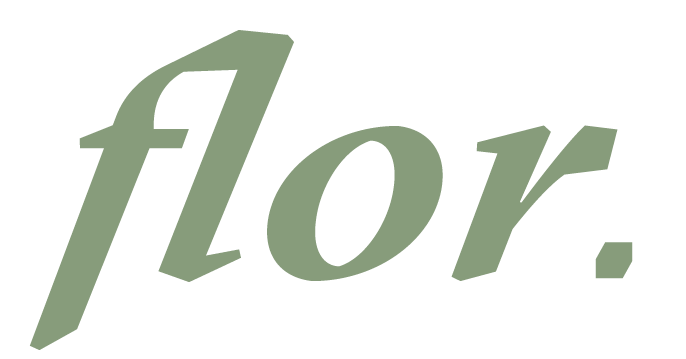21.1.2025
XX Y X + IMA
IMAfiction portrait #04: Eliane Radigue
Screening
Pia Palme & Rhodri Davies play Eliane Radigue's OCCAM
Live performance
echoraum Vienna
IMAfiction Portrait #04 | Eliane Radigue
A portrait by IMA, filmed in Paris (2006)
Eliane Radigue has composed electronic music since the sixties. She is the only French woman composer of her generation who can be considered to be a pioneer of this genre, and of minimal music as well.
“Her music is a slow flux of dense sounds subject to imperceptible mutations. A timeless architecture of deep vibrations speaking not to the intellect or to hearing, but to the entire body. A music which is unsettling if one submerges oneself in it. A music that possesses the monumental subtlety of the movement of oceans. Emmanuel Holterbach” (Emmanuel Holterbach) Translation Leslie Stuck
interviews: Cornelia Primosch (ORF), Daniela Swarowsky
camera: Sepp Thoma (ORF), Anais Prosaic
film editing: Elena Tikhonova, Anais Prosaic
sound recording: Henry Roux (ORF)
sound editing: Elisabeth Schimana
film format: 4:3
language: Französisch
subtiteles: English, German
duration: 15 min
bonus audio track: Jetsun Mila, 84 min
Supported by Niederösterreich Kultur, BM:UKK, ars electronica, ORF Oberösterreich und Bundeskanzleramt Österreich
Eliane Radigue was born on the 24th of January 1932 and grew up in Paris. During her childhood, she studied piano, harp and choral singing. During the 1950s she lived in Nice and “played around with the dodecaphonic series” she said, which she taught herself, after having read the “Treatise on Harmony” by Arnold Schoenberg. She married the sculptor Arman in the early 1950s. In 1954 she discovered Concrete Music on the radio. Fate and circumstances led to her meeting Pierre Schaeffer a few months later, who invited her to go to the O.R.T.F test Studio. She learned studio techniques there, along with the special features of this music. Between 1955 and 1957 she gave a number of lectures on Concrete Music (in Darmstadt, particularly). In 1958, a wife and mother of three children, she put her musical research and studies on hold. During this period Yves Klein, a friend of the family, asked for advice about the composition of his ” Monotone Symphony: Silence” – she recommended that he commission her friend Louis Saguer to arrange the score.
In 1961 the family lived for just over a year in New York, and Eliane Radigue met some crucial people both in the world of the arts (she played chess with Marcel Duchamp) and in the world of music (James Tenney, who she considered to be her mentor, Philip Glass, Steve Reich and John Gibson also became close friends). In 1967, Eliane Radigue and Arman separated. She became an assistant to Pierre Henry with whom she worked for a little over a year, particularly on “The Apocalypse of Jean”. The work on this major piece is very intense: Pierre Henry gave Eliane Radigue two Tolana tape recorders and a mixing desk, which enabled her to set up a small studio in her house, so she could work at home during the most active period of the final mix. Her first piece “Electronic Games” (1967) was composed in Pierre Henry’s studio. The rest were composed at home. The minimalism of her studio would define part of her aesthetics she mainly worked by adding distortion effects to intensive studio techniques: slowing down, superimposing, feedback between two tape recorders, etc.
In 1969 she stopped working for Pierre Henry and dedicated herself to her own work. During 1969 and 1970 she developed a unique approach to the manipulation of distortion techniques and composed works of unlimited duration intended to be broadcast in a space with a number of endless looped tapes, of different lengths, which in mixing together produced a perpetually changing soundtrack. This is the case with “In memoriam Ostinato” (1969), “Omnht” (1970) and “Vice, Versa, etc…” (1970) – sold in groups by the Lara Vincy Gallery in the form of a number of magnetic tapes, limited to 10 signed and numbered copies. Also worth remarking on is her recording of 45 works available to the public “Sigma = a = b = a + b” (1969) premiered at the time at Yvon Lambert’s premises. During this period, her approach to sound was very flexible. Sound is seen as a material for inhabiting space, which it then presents using the term “sound proposals”. These are sound installations, even though this name was not often used From the end of 1970, “Opus 17” is one of her first pieces with a fixed length, and it coincided with the need she felt to broaden her range of sounds. When she heard about the first modular synthesisers, she decided to return to the United States in September, raking up a residency with the University of New York. There, she studied the working of the Buchla synthesiser. This was when she met Laurie Spiegel and Rhys Chatham, who also worked in the New York University Studios. After a period of experimentation she opted for an ARP 2500 synthesiser. One detail that helps to illustrate her approach: she refused to hang onto the keyboard, “to avoid making it too easy” she said, and she worked on sounds from the control desk.
From 1971 to 1974 she composed her first electronic works and gave up her work on asynchronous looped tapes, for a method of composition that relies on “touch”: imperceptible transitions from one world of sound to another. She began to present this “infinitely discreet music, alongside which all others seem to be tugging at your sleeve” to use the words of Michel Chion. In addition, the ARP 2500 synthesiser allowed her to explore the world of harmonics and bass vibrations graves in such a way that the music seemed to “come out of the walls” in the words of Tom Johnson. It was during this period that she composed “Chryptus” (1971), “Geelriandre” (1972) – a unique mixed work by Eliane Radigue combining the piano parts of Gérard Frémy with the fluid sounds of the ARP. Gérard Frémy has been a fierce defender of the work of Eliane Radigue from 1969 – “Psi 847” (1973), “Arthesis” (1973) – which contain traces of input from the Moog of the California Institute of the Arts – “Biogenesis” (1973), “Transamorem-Transmortem” (1973) – one of her last pieces written to be a sound installation – and “Adnos I” (1974). During the 1970s Eliane Radigue travelled to, and stayed in, the United States on many occasions and met Charlemagne Palestine, David Behrman, Robert Ashley, Alvin Lucier, Phill Niblock, Anna Lockwood, Maggi Payne, Pauline Oliveros and David Rosenboom, among others… with whom she shared friendly rivalry and friendship. In France she met Michèle Bokanowski through their mutual friend Gérard Frémy. During the 1970s and 80s, Michèle Bokanowski demanded that tracks by Eliane Radigue be included in her own compositions, as well in the soundtracks for the films by her husband Patrick Bokanowski. As a result, you can hear the ARP of Eliane Radigue most notable in “The Angel”, one of the masterpieces by this experimental film maker. In 1974 after a performance of “Adnos I” in San Francisco, a group of French students led her to discover Tibetan Buddhism. On her return to Paris, she began an in-depth search into her spirituality and this slowed down her musical output until 1978.
Between 1978 and 1993, she composed a number of her greatest works. “Adnos II” (1980), “Adnos III” (1981), “The Songs of Milarepa” (1983) – with the voice of Lama Kunga Rinpoche and Robert Ashley – “Jetsun Mila” (1986), as well as the three parts of the “Trilogy of Death”, “Kyema” (1988), “Kailasha” (1991) and “Koume” (1993). All of these are informed and inspired by Tibetan Buddhism, while all remaining profane – Eliane Radigue insists on this point. In 1989 her son was killed in a car accident, which had a long-lasting effect on her. In 1998 she was invited to spend two months as a professor at Mills College in Oakland. She presented the “Labyrinth Sound”, using the sounds of an ARP punctuated by solos from numerous musicians including Pauline Oliveros, Maggi Payne, William Winant or David Abel.
In 2000 she composed her last electronic work, “L’île re-sonante ” [the Echoing Isle], which won her the Golden Nica at the Electronic Arts Festival in Linz in 2006. Following a suggestion by Kasper Tœplitz, in 2003 she began work on a composition for one or more instrumentalists, with whom she worked intensively during the creative process. Since 2004, she has collaborated with Charles Curtis – a virtuoso cellist for whom La Monte Young and Alvin Lucier have written pieces – which has led her to focus exclusively on acoustic sounds. This experience continued with Carol Robinson and Bruno Martinez, both basset horn players. With these three musicians, she composed the remarkable cycle in three parts “Naldjorlak”. She has been producing this music with its infinitely delicate and enchanting tones that last without breaking the aesthetics and the beauty of her electronic work. Emmanuel Holterbach (Translation Brainstorm)
Participation in IMA projects
IMAfiction portrait #04
Hidden Alliances_versteckt verbunden
Eliane Radigue
To celebrate the composer’s 93th birthday, Pia Palme and Rhodri Davies play Éliane Radigue (Live Performance)
OCCAM XVIII for bass recorder
OCCAM I for harp
OCCAM RIVER V for harp and bass recorder
Harp: Rhodri Davies
Double Bass Recorder: Pia Palme
Éliane Radigue on Occam Ocean
[Program notes by Radigue for the premiere of Occam XVIII and Occam River V at Phipps Hall, University of Huddersfield, UK, 2014]
The idea for this piece was initially inspired by a large mural that I saw by chance in 1973, at the Museum of Natural History in Los Angeles. It showed the “spectrum of electromagnetic waves” moving from the largest to the smallest of known measurable wavelengths. Out of this large spectrum, there is a tiny zone from slightly less than 100 Hz to slightly more than 10 KHz that the ears of certain species populating the planet earth, have transformed into “sounds”.
Later, I discovered interesting parallels with several of my reflections on William of Ockham and his famous treatise “Ockham’s Razor”. Expressed most succinctly in his own words, “The simplest, the best”, it has been adapted and used by numerous artist/creators. Last came the distant recollection of a science fiction story I had read about the existence of a mythical ocean. Only the title remained etched in my memory, “Occam’s Razor”, which explains the origin of the spelling I chose. It seems in fact that the Ocean with its multiple waves allows us to symbolically be in contact with a rather large spectrum of vibrating undulations, stretching from the great deep-sea swells to wavelets sparkling on a fine summer day. This explains the overall “structure” of the project.
The work mode is based on an individual “image” illustrated and evoked within each solo. Each musician is guided by his or her personal “image”. This provides the essential, letting descriptive words and evocations establish a system of communication as the piece is being elaborated, and through this intuitive-instinctive process, we are guided to the very essence of music. There will be as many solos as there are volunteers willing to enter into this shared experience. They become the “sources”.
Occam XVIII [Program notes by Pia Palme]
Breath and tongue coax the long air column of the contrabass recorder into vibration. Generously the air flows through the instrument, in and out. A low sound appears at first, later pulsing partials start to oscillate. As the instrument surrenders, fractal moments of articulation gather like beads on a string. Is there an end to the flow, is there a beginning? What happens between the in-breath and the out-breath? Is continuity a mere illusion? A few days after Eliane’s 82nd birthday in 2014 work on Occam XVIII was finished, accompanied by the perfume of abundant flower bouquets in her living room.
Pia Palme is a composer, artistic researcher, musician, writer and activist in the field of contemporary music and experimental music theatre. She is based in Vienna, Austria. Her work and publications often engage with ecology, feminism and post-humanism, offering insights into the state of the Earth and speculative futures. She facilitates cross-disciplinary initiatives and engages in collaborative projects with sound as a fundamental element. As a musician and improviser, Palme performs with bass recorders and electronics.
Pia Palme
Rhodri Davies is immersed in the worlds of improvisation, musical experimentation, composition and contemporary classical performance. He plays harp, electric harp, live-electronics and builds wind, water, ice, dry ice and fire harp installations and has released eight solo albums. His regular groups include: HEN OGLEDD, Magda Mayas‘ Filamental, In Situ Ens., Cranc, Common Objects and a duo with John Butcher. He has worked with the following artists: David Sylvian, Jenny Hval, Derek Bailey, Sofia Jernberg, Lina Lapelyte, Pat Thomas, Simon H Fell and Will Gaines. For the last thirteen years Davies has been closely associated with the pioneering composer Eliane Radigue performing eighteen of her pieces. She composed OCCAM I for Davies in 2011, the first in an ongoing series of solo and ensemble pieces for individual instrumentalists in which a performer’s personal performance technique and particular relationship to their instrument function as the compositional material of the piece. New pieces for solo harp have also been composed for him by: Christian Wolff, Carole Finer, Philip Corner, Phill Niblock, Ben Patterson, Alison Knowles, Taku Sugimoto, Mieko Shiomi and Yasunao Tone. In 2008 he collaborated with the visual artist Gustav Metzger on ‘Self-cancellation’, a large-scale audio-visual collaboration in London and Glasgow. In 2012 he was the recipient of the Foundation for Contemporary Arts, Grants to Artists Award, he was a Chapter Associate Artist (2016-19) and in 2017 he received a Creative Wales Award. He is a co-organiser of the NAWR concert series in Swansea.
Rhodri Davies
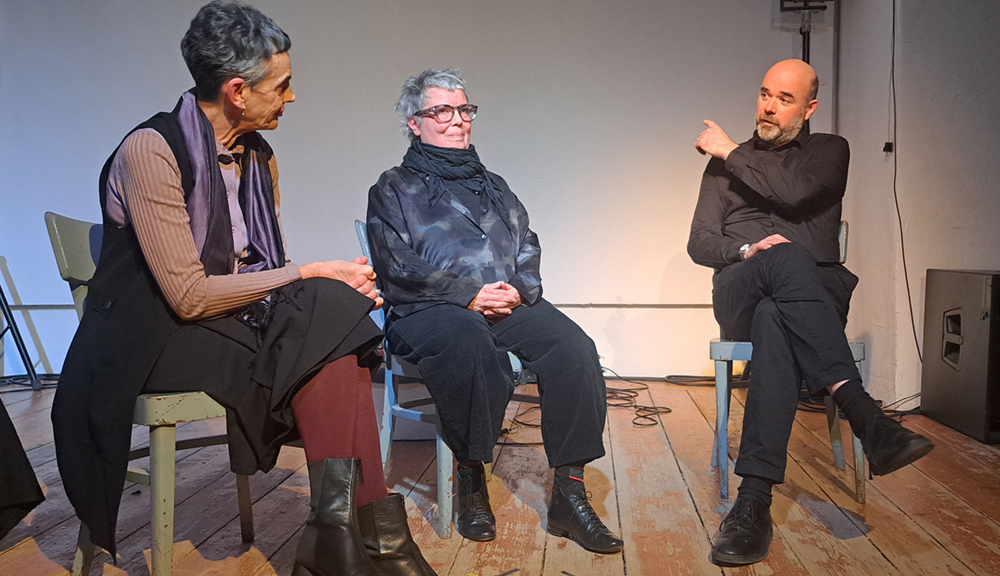

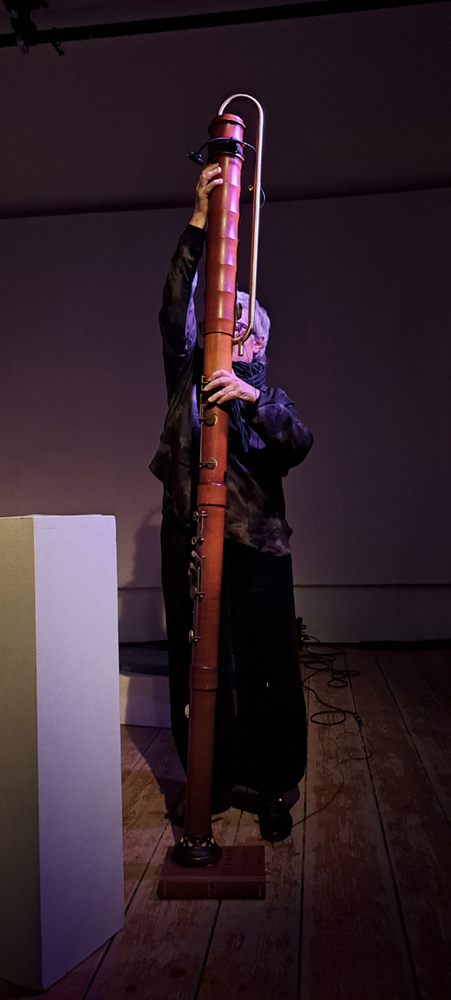
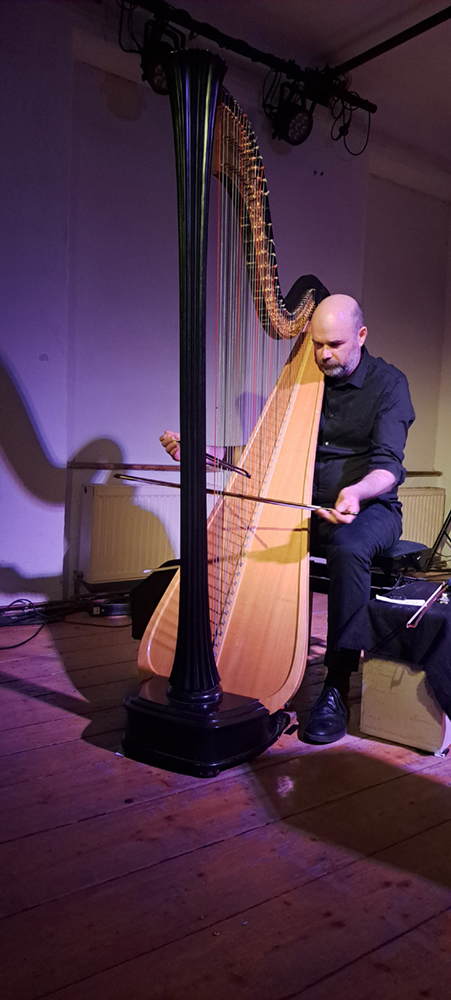
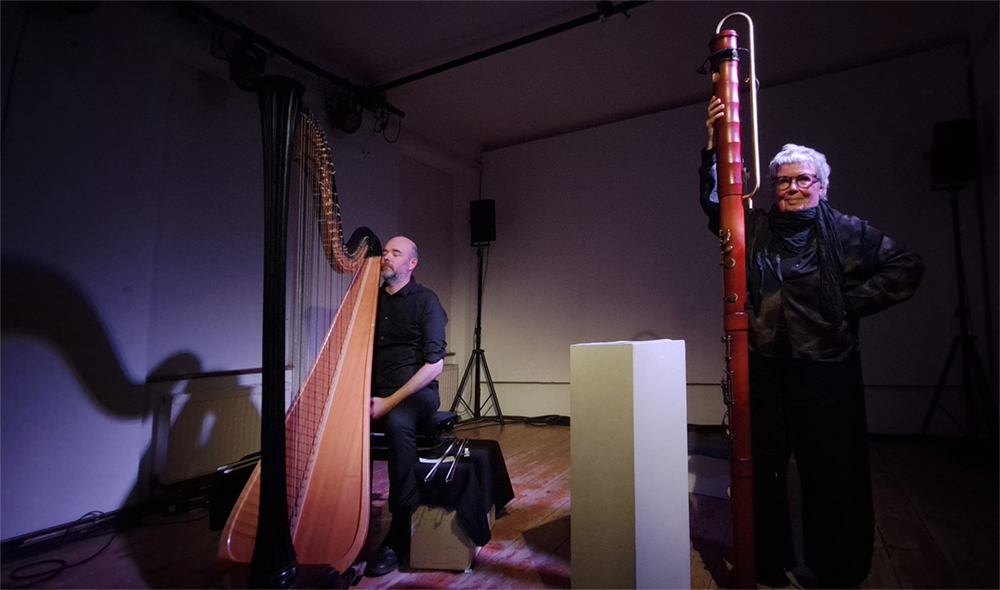
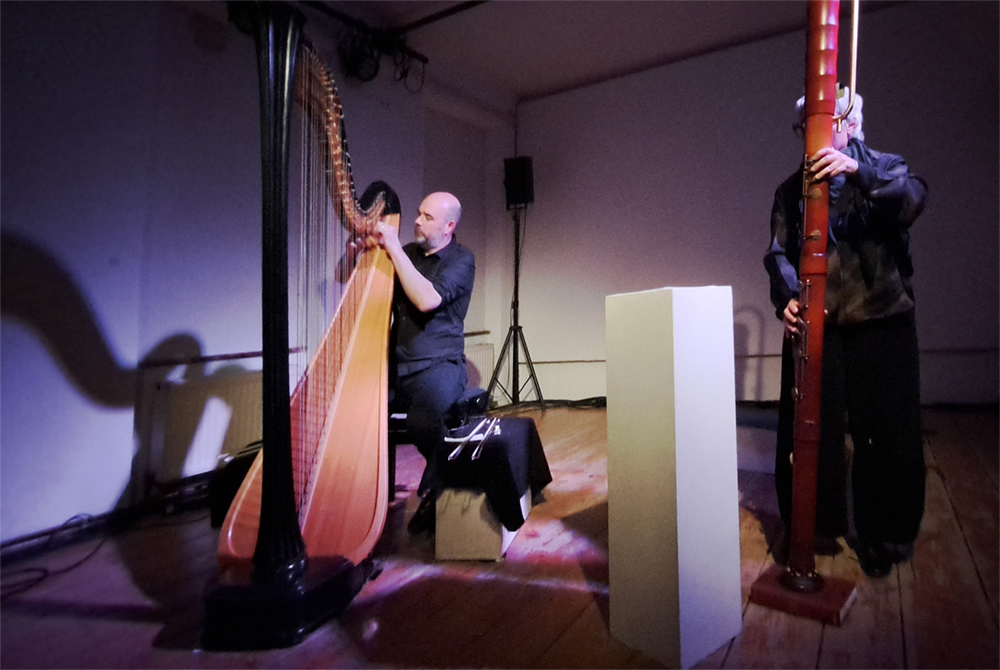
29.4.
XX Y X + IMA
IMAfiction portrait #09: Beatriz Ferreyra
Screening
Marta Beauchamp: String Player
Live performance
echoraum Vienna
IMAfiction Portrait #09 | Beatriz Ferreyra
A portrait by Nathalie Singer & Elisabeth Schimana (2017)
Beatriz Ferreyra (*1937) is an Argentine composer. She uses the technique of changing perspectives for her compositions, which she is familiar with from Pierre Schaeffer's concept of reduced listening: one perceives the sound as such, not as an effect or indication of something else.
Composing is a physical process for Ferreyra, she composes very intuitively and has no rules. ‘It either works or it doesn't.’ For a long time, she lacked the strategies to control the compositional process. In the meantime, anything, whether image, sound, colour or form, can be the beginning of her associative composing.
Each of Ferreyra's compositions has its own sounds; she never reuses sounds from one piece for another, but the nature of her sounds is unlimited. She uses the microphone to record animals, people or machines: Her garden and household appliances serve as sound sources for ‘Les Larmes de l'inconnu’: Hedge trimmers, lawnmowers, drills, chainsaws.
The large soundscapes in ‘La rivière de l'oiseaux’ (1998/99) are based on grids generated from short, overlapping tones. The composition deals with discoveries that Ferreyra had recently made in Argentina, the death of her father and a strange, bad dream about Uruguay - this word of the Argentinian Indians for the ‘river of birds’ ultimately led her to the title of this work.
Compositions: Médisances (1968), Canto del Loco (1974), Dans un point infini (2005), L'autre rive (2007), Un fil invisible (2009/10), Les larmes de l'inconnu (2011), the triology ‘La rivière des oiseaux’
IMAfiction Portrait #09 | Beatriz Ferreyra
shot at Beatriz Ferreyra’s cottage in France
Concept: Nathalie Singer & Elisabeth Schimana
Interview: Nathalie Singer
Camera: Reinhard Mayr
Cut: Reinhard Mayr
Music: Beatriz Ferreyra
Sound editing: Robert Eder
Subtitles translation: Anna Graf (German), Kimi Lum (English)
Graphic design: Andreas Rathmanner, FOX, Nora Bischof
DVD authoring: CSM Production
Photo credits: Archive Beatriz Ferreyra, http://hd-fotografia.blogspot.co.at/2013/10/
(Archivo General de la Nación Colombia, Secretaría de Planeamiento, Buenos Aires)
Format: 16:9
Duration: 31min
Language: French
Subtitles: German, English
IMAfiction_portrait09
GRM works
“string player” is a 25 minute composition for cello, string and objects.The work started on the day I found miniature models of balancing sculptures, which I produced for a sound installa- tion in 2017, while searching for something else. Back then I exhibited them as resting bodies, self-sufficiently hovering in a small space of balance surrounded by a large space within which to fall into. Statue-like they could not per- form motion; the richness of possible positions that their joints could move to was not exhibited, but rather frozen in sketches preserved in my notebooks. I returned to these sketches and reproduced one of the models as a large-scale prototype, using thin and long paper tubes that a shop on Meidlinger Hauptstrasse kept aside for me for pickup at 1pm on a cold winter day, and string. To bring colour to the tubes I wrapped them with thin orange and green poly- ester thread, closing off the ends with tape. The prototype was designed so that I could play cello inside it or with it: cello playing as an action to move the object, the dynamics of the object defining a new way of cello-playing.
Marta Beauchamp (*1990, IT/UK, based in Vienna) is a sound artist, musician and artistic researcher. Marta currently holds a PhD scholarship at the Research Collective graduate program of Kunstuniversität Linz. In her project “Tipping points in transmediation” she employs transmediation as a methodology to work between scientific narratives concerned with biological rhythms and performative and installation sonic spaces. Sound and objects allow her to inflate dense scientific topics to room-scale installations which offer more space and dimensions for comprehension. As an internationally performing musician, Marta performs cello, bass and tubes.
marta beauchamp
bg.klingt.org
concatenate.it
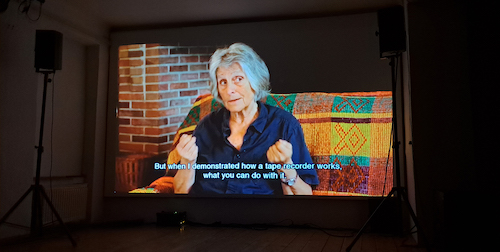
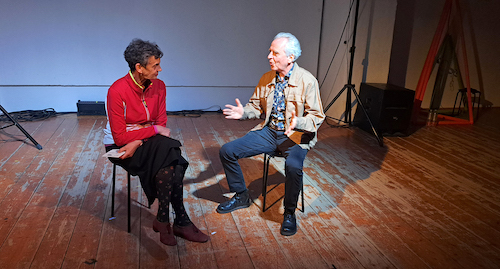
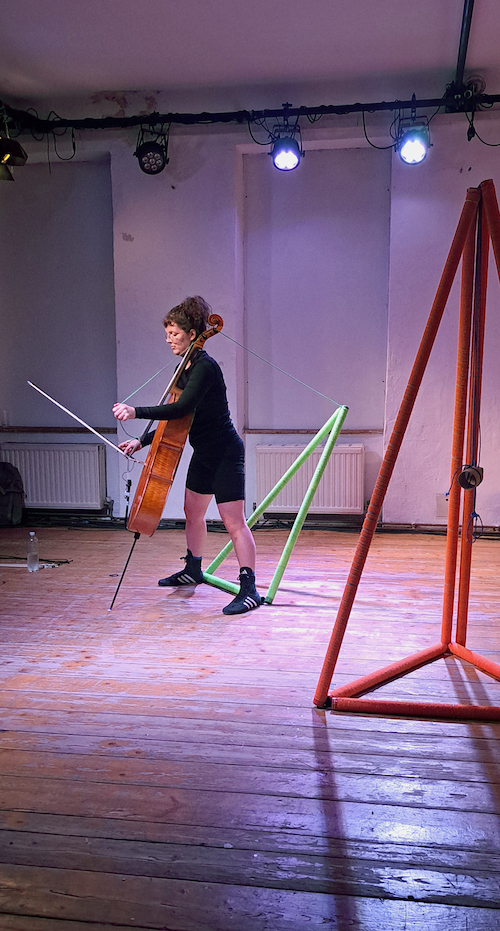
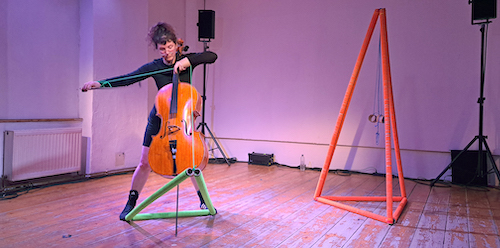
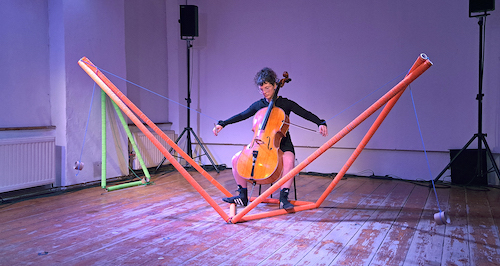
20.5.
VOICES III:
2 Films by Miriam Bajtala: The Only Song I Remember In Slovak, 3 Stimmen/3 Voices
Screening
CHRA WONDEREEL
Live performance & album presentation
echoraum Vienna
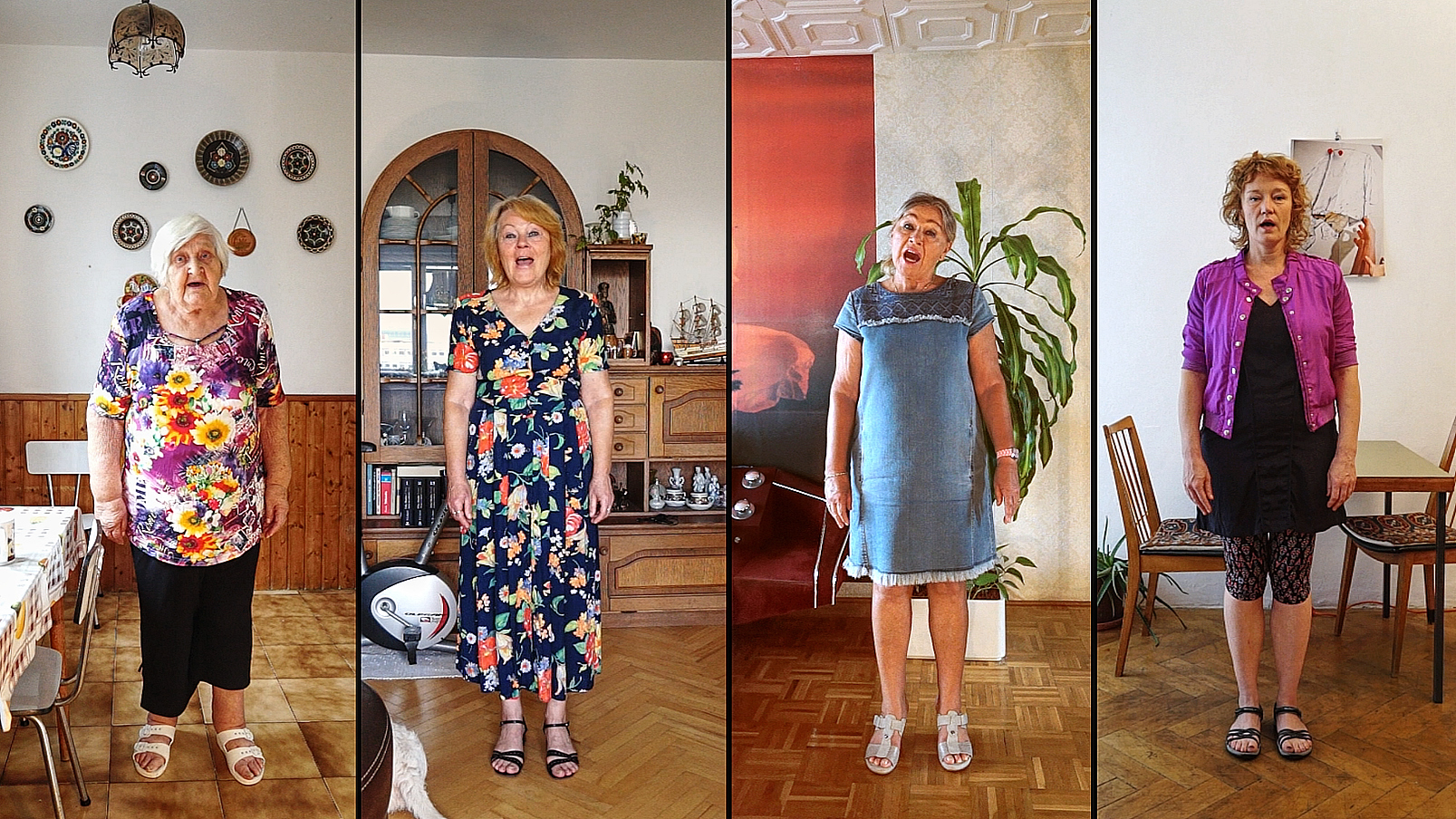
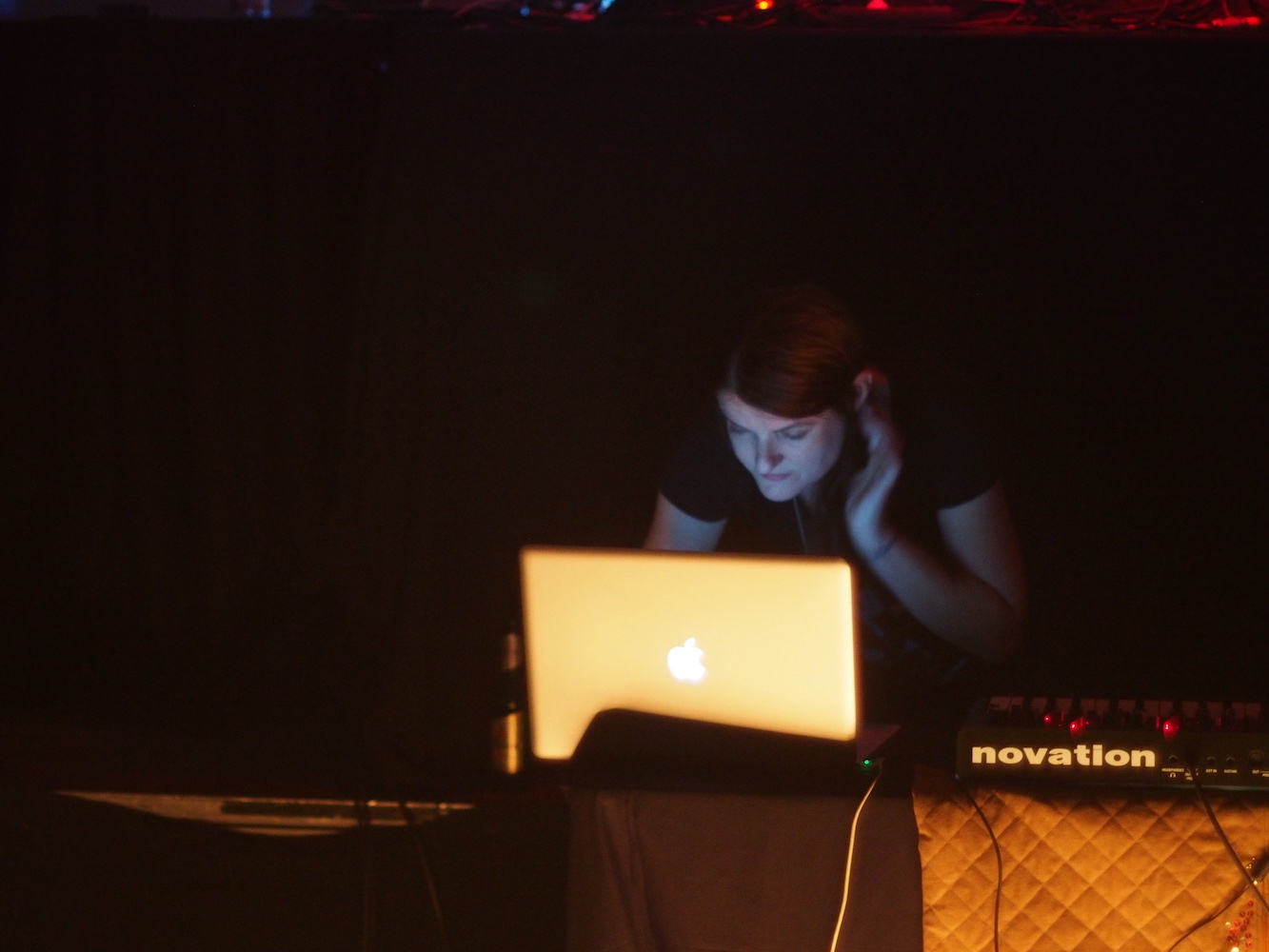
Miriam Bajtala (Screening)
DREI STIMMEN / THREE VOICES
2011, Video, 12:54 min
The video begins with a text detailing my emigration to Austria: the social and economic conditions, the language learning, and the loss of language. Two performers can be seen reading the text in German (Markus Heinicke) and English (Anna Mendelssohn). The Slovak part is heard as an off–screen voice. Three Voices is not a translation, even though you hear a text in three languages. It also isn’t a dialog, despite two people being visible who are speaking and partially referring to one another. The film depicts a condensed approach to history, language, expression, and what remaining silent can mean. It showcases speaking to acquire language in front of a camera. What is necessary is said: from the starting point in German, speech returns in English, and ultimately Slovak: I take ownership of the language that I have almost lost. Teil von Nichts als Gespenster. Part of Nothing but ghosts.
THE ONLY SONG I REMEMBER IN SLOVAK
2017, Video, 5:00 min
The only song I remember in Slovak is a video that gathers three generations of women, each singing a Slovak folk song in their home, and compares spaces, generations, song interpretations, and relationships. The fourfold performance is mounted in such a way that all women (grandma–aunt–mother–daughter), although standing in their rooms, sing a song together, the only one I can still sing in Slovak. Teil von Nichts als Gespenster. Part of Nothing but ghosts.
miriam bajtala
chra, the electronic music artist, is recognized for her compelling use of field recordings and low frequencies. Through integration of these elements, she weaves a distinctive sonic tapestry, offering listeners an immersive experience that transcends traditional electronic music boundaries. releases: editions mego, trost records, comfortzone, tsuki boshi, blackest ever black, jsme amm
CHRA
XX Y X + IMA
IMAfiction portrait #04: Eliane Radigue
Screening
Pia Palme & Rhodri Davies play Eliane Radigue's OCCAM
Live performance
echoraum Vienna
IMAfiction Portrait #04 | Eliane Radigue
A portrait by IMA, filmed in Paris (2006)
Eliane Radigue has composed electronic music since the sixties. She is the only French woman composer of her generation who can be considered to be a pioneer of this genre, and of minimal music as well.
“Her music is a slow flux of dense sounds subject to imperceptible mutations. A timeless architecture of deep vibrations speaking not to the intellect or to hearing, but to the entire body. A music which is unsettling if one submerges oneself in it. A music that possesses the monumental subtlety of the movement of oceans. Emmanuel Holterbach” (Emmanuel Holterbach) Translation Leslie Stuck
interviews: Cornelia Primosch (ORF), Daniela Swarowsky
camera: Sepp Thoma (ORF), Anais Prosaic
film editing: Elena Tikhonova, Anais Prosaic
sound recording: Henry Roux (ORF)
sound editing: Elisabeth Schimana
film format: 4:3
language: Französisch
subtiteles: English, German
duration: 15 min
bonus audio track: Jetsun Mila, 84 min
Supported by Niederösterreich Kultur, BM:UKK, ars electronica, ORF Oberösterreich und Bundeskanzleramt Österreich
Eliane Radigue was born on the 24th of January 1932 and grew up in Paris. During her childhood, she studied piano, harp and choral singing. During the 1950s she lived in Nice and “played around with the dodecaphonic series” she said, which she taught herself, after having read the “Treatise on Harmony” by Arnold Schoenberg. She married the sculptor Arman in the early 1950s. In 1954 she discovered Concrete Music on the radio. Fate and circumstances led to her meeting Pierre Schaeffer a few months later, who invited her to go to the O.R.T.F test Studio. She learned studio techniques there, along with the special features of this music. Between 1955 and 1957 she gave a number of lectures on Concrete Music (in Darmstadt, particularly). In 1958, a wife and mother of three children, she put her musical research and studies on hold. During this period Yves Klein, a friend of the family, asked for advice about the composition of his ” Monotone Symphony: Silence” – she recommended that he commission her friend Louis Saguer to arrange the score.
In 1961 the family lived for just over a year in New York, and Eliane Radigue met some crucial people both in the world of the arts (she played chess with Marcel Duchamp) and in the world of music (James Tenney, who she considered to be her mentor, Philip Glass, Steve Reich and John Gibson also became close friends). In 1967, Eliane Radigue and Arman separated. She became an assistant to Pierre Henry with whom she worked for a little over a year, particularly on “The Apocalypse of Jean”. The work on this major piece is very intense: Pierre Henry gave Eliane Radigue two Tolana tape recorders and a mixing desk, which enabled her to set up a small studio in her house, so she could work at home during the most active period of the final mix. Her first piece “Electronic Games” (1967) was composed in Pierre Henry’s studio. The rest were composed at home. The minimalism of her studio would define part of her aesthetics she mainly worked by adding distortion effects to intensive studio techniques: slowing down, superimposing, feedback between two tape recorders, etc.
In 1969 she stopped working for Pierre Henry and dedicated herself to her own work. During 1969 and 1970 she developed a unique approach to the manipulation of distortion techniques and composed works of unlimited duration intended to be broadcast in a space with a number of endless looped tapes, of different lengths, which in mixing together produced a perpetually changing soundtrack. This is the case with “In memoriam Ostinato” (1969), “Omnht” (1970) and “Vice, Versa, etc…” (1970) – sold in groups by the Lara Vincy Gallery in the form of a number of magnetic tapes, limited to 10 signed and numbered copies. Also worth remarking on is her recording of 45 works available to the public “Sigma = a = b = a + b” (1969) premiered at the time at Yvon Lambert’s premises. During this period, her approach to sound was very flexible. Sound is seen as a material for inhabiting space, which it then presents using the term “sound proposals”. These are sound installations, even though this name was not often used From the end of 1970, “Opus 17” is one of her first pieces with a fixed length, and it coincided with the need she felt to broaden her range of sounds. When she heard about the first modular synthesisers, she decided to return to the United States in September, raking up a residency with the University of New York. There, she studied the working of the Buchla synthesiser. This was when she met Laurie Spiegel and Rhys Chatham, who also worked in the New York University Studios. After a period of experimentation she opted for an ARP 2500 synthesiser. One detail that helps to illustrate her approach: she refused to hang onto the keyboard, “to avoid making it too easy” she said, and she worked on sounds from the control desk.
From 1971 to 1974 she composed her first electronic works and gave up her work on asynchronous looped tapes, for a method of composition that relies on “touch”: imperceptible transitions from one world of sound to another. She began to present this “infinitely discreet music, alongside which all others seem to be tugging at your sleeve” to use the words of Michel Chion. In addition, the ARP 2500 synthesiser allowed her to explore the world of harmonics and bass vibrations graves in such a way that the music seemed to “come out of the walls” in the words of Tom Johnson. It was during this period that she composed “Chryptus” (1971), “Geelriandre” (1972) – a unique mixed work by Eliane Radigue combining the piano parts of Gérard Frémy with the fluid sounds of the ARP. Gérard Frémy has been a fierce defender of the work of Eliane Radigue from 1969 – “Psi 847” (1973), “Arthesis” (1973) – which contain traces of input from the Moog of the California Institute of the Arts – “Biogenesis” (1973), “Transamorem-Transmortem” (1973) – one of her last pieces written to be a sound installation – and “Adnos I” (1974). During the 1970s Eliane Radigue travelled to, and stayed in, the United States on many occasions and met Charlemagne Palestine, David Behrman, Robert Ashley, Alvin Lucier, Phill Niblock, Anna Lockwood, Maggi Payne, Pauline Oliveros and David Rosenboom, among others… with whom she shared friendly rivalry and friendship. In France she met Michèle Bokanowski through their mutual friend Gérard Frémy. During the 1970s and 80s, Michèle Bokanowski demanded that tracks by Eliane Radigue be included in her own compositions, as well in the soundtracks for the films by her husband Patrick Bokanowski. As a result, you can hear the ARP of Eliane Radigue most notable in “The Angel”, one of the masterpieces by this experimental film maker. In 1974 after a performance of “Adnos I” in San Francisco, a group of French students led her to discover Tibetan Buddhism. On her return to Paris, she began an in-depth search into her spirituality and this slowed down her musical output until 1978.
Between 1978 and 1993, she composed a number of her greatest works. “Adnos II” (1980), “Adnos III” (1981), “The Songs of Milarepa” (1983) – with the voice of Lama Kunga Rinpoche and Robert Ashley – “Jetsun Mila” (1986), as well as the three parts of the “Trilogy of Death”, “Kyema” (1988), “Kailasha” (1991) and “Koume” (1993). All of these are informed and inspired by Tibetan Buddhism, while all remaining profane – Eliane Radigue insists on this point. In 1989 her son was killed in a car accident, which had a long-lasting effect on her. In 1998 she was invited to spend two months as a professor at Mills College in Oakland. She presented the “Labyrinth Sound”, using the sounds of an ARP punctuated by solos from numerous musicians including Pauline Oliveros, Maggi Payne, William Winant or David Abel.
In 2000 she composed her last electronic work, “L’île re-sonante ” [the Echoing Isle], which won her the Golden Nica at the Electronic Arts Festival in Linz in 2006. Following a suggestion by Kasper Tœplitz, in 2003 she began work on a composition for one or more instrumentalists, with whom she worked intensively during the creative process. Since 2004, she has collaborated with Charles Curtis – a virtuoso cellist for whom La Monte Young and Alvin Lucier have written pieces – which has led her to focus exclusively on acoustic sounds. This experience continued with Carol Robinson and Bruno Martinez, both basset horn players. With these three musicians, she composed the remarkable cycle in three parts “Naldjorlak”. She has been producing this music with its infinitely delicate and enchanting tones that last without breaking the aesthetics and the beauty of her electronic work. Emmanuel Holterbach (Translation Brainstorm)
Participation in IMA projects
IMAfiction portrait #04
Hidden Alliances_versteckt verbunden
Eliane Radigue
To celebrate the composer’s 93th birthday, Pia Palme and Rhodri Davies play Éliane Radigue (Live Performance)
OCCAM XVIII for bass recorder
OCCAM I for harp
OCCAM RIVER V for harp and bass recorder
Harp: Rhodri Davies
Double Bass Recorder: Pia Palme
Éliane Radigue on Occam Ocean
[Program notes by Radigue for the premiere of Occam XVIII and Occam River V at Phipps Hall, University of Huddersfield, UK, 2014]
The idea for this piece was initially inspired by a large mural that I saw by chance in 1973, at the Museum of Natural History in Los Angeles. It showed the “spectrum of electromagnetic waves” moving from the largest to the smallest of known measurable wavelengths. Out of this large spectrum, there is a tiny zone from slightly less than 100 Hz to slightly more than 10 KHz that the ears of certain species populating the planet earth, have transformed into “sounds”.
Later, I discovered interesting parallels with several of my reflections on William of Ockham and his famous treatise “Ockham’s Razor”. Expressed most succinctly in his own words, “The simplest, the best”, it has been adapted and used by numerous artist/creators. Last came the distant recollection of a science fiction story I had read about the existence of a mythical ocean. Only the title remained etched in my memory, “Occam’s Razor”, which explains the origin of the spelling I chose. It seems in fact that the Ocean with its multiple waves allows us to symbolically be in contact with a rather large spectrum of vibrating undulations, stretching from the great deep-sea swells to wavelets sparkling on a fine summer day. This explains the overall “structure” of the project.
The work mode is based on an individual “image” illustrated and evoked within each solo. Each musician is guided by his or her personal “image”. This provides the essential, letting descriptive words and evocations establish a system of communication as the piece is being elaborated, and through this intuitive-instinctive process, we are guided to the very essence of music. There will be as many solos as there are volunteers willing to enter into this shared experience. They become the “sources”.
Occam XVIII [Program notes by Pia Palme]
Breath and tongue coax the long air column of the contrabass recorder into vibration. Generously the air flows through the instrument, in and out. A low sound appears at first, later pulsing partials start to oscillate. As the instrument surrenders, fractal moments of articulation gather like beads on a string. Is there an end to the flow, is there a beginning? What happens between the in-breath and the out-breath? Is continuity a mere illusion? A few days after Eliane’s 82nd birthday in 2014 work on Occam XVIII was finished, accompanied by the perfume of abundant flower bouquets in her living room.
Pia Palme is a composer, artistic researcher, musician, writer and activist in the field of contemporary music and experimental music theatre. She is based in Vienna, Austria. Her work and publications often engage with ecology, feminism and post-humanism, offering insights into the state of the Earth and speculative futures. She facilitates cross-disciplinary initiatives and engages in collaborative projects with sound as a fundamental element. As a musician and improviser, Palme performs with bass recorders and electronics.
Pia Palme
Rhodri Davies is immersed in the worlds of improvisation, musical experimentation, composition and contemporary classical performance. He plays harp, electric harp, live-electronics and builds wind, water, ice, dry ice and fire harp installations and has released eight solo albums. His regular groups include: HEN OGLEDD, Magda Mayas‘ Filamental, In Situ Ens., Cranc, Common Objects and a duo with John Butcher. He has worked with the following artists: David Sylvian, Jenny Hval, Derek Bailey, Sofia Jernberg, Lina Lapelyte, Pat Thomas, Simon H Fell and Will Gaines. For the last thirteen years Davies has been closely associated with the pioneering composer Eliane Radigue performing eighteen of her pieces. She composed OCCAM I for Davies in 2011, the first in an ongoing series of solo and ensemble pieces for individual instrumentalists in which a performer’s personal performance technique and particular relationship to their instrument function as the compositional material of the piece. New pieces for solo harp have also been composed for him by: Christian Wolff, Carole Finer, Philip Corner, Phill Niblock, Ben Patterson, Alison Knowles, Taku Sugimoto, Mieko Shiomi and Yasunao Tone. In 2008 he collaborated with the visual artist Gustav Metzger on ‘Self-cancellation’, a large-scale audio-visual collaboration in London and Glasgow. In 2012 he was the recipient of the Foundation for Contemporary Arts, Grants to Artists Award, he was a Chapter Associate Artist (2016-19) and in 2017 he received a Creative Wales Award. He is a co-organiser of the NAWR concert series in Swansea.
Rhodri Davies






29.4.
XX Y X + IMA
IMAfiction portrait #09: Beatriz Ferreyra
Screening
Marta Beauchamp: String Player
Live performance
echoraum Vienna
IMAfiction Portrait #09 | Beatriz Ferreyra
A portrait by Nathalie Singer & Elisabeth Schimana (2017)
Beatriz Ferreyra (*1937) is an Argentine composer. She uses the technique of changing perspectives for her compositions, which she is familiar with from Pierre Schaeffer's concept of reduced listening: one perceives the sound as such, not as an effect or indication of something else.
Composing is a physical process for Ferreyra, she composes very intuitively and has no rules. ‘It either works or it doesn't.’ For a long time, she lacked the strategies to control the compositional process. In the meantime, anything, whether image, sound, colour or form, can be the beginning of her associative composing.
Each of Ferreyra's compositions has its own sounds; she never reuses sounds from one piece for another, but the nature of her sounds is unlimited. She uses the microphone to record animals, people or machines: Her garden and household appliances serve as sound sources for ‘Les Larmes de l'inconnu’: Hedge trimmers, lawnmowers, drills, chainsaws.
The large soundscapes in ‘La rivière de l'oiseaux’ (1998/99) are based on grids generated from short, overlapping tones. The composition deals with discoveries that Ferreyra had recently made in Argentina, the death of her father and a strange, bad dream about Uruguay - this word of the Argentinian Indians for the ‘river of birds’ ultimately led her to the title of this work.
Compositions: Médisances (1968), Canto del Loco (1974), Dans un point infini (2005), L'autre rive (2007), Un fil invisible (2009/10), Les larmes de l'inconnu (2011), the triology ‘La rivière des oiseaux’
IMAfiction Portrait #09 | Beatriz Ferreyra
shot at Beatriz Ferreyra’s cottage in France
Concept: Nathalie Singer & Elisabeth Schimana
Interview: Nathalie Singer
Camera: Reinhard Mayr
Cut: Reinhard Mayr
Music: Beatriz Ferreyra
Sound editing: Robert Eder
Subtitles translation: Anna Graf (German), Kimi Lum (English)
Graphic design: Andreas Rathmanner, FOX, Nora Bischof
DVD authoring: CSM Production
Photo credits: Archive Beatriz Ferreyra, http://hd-fotografia.blogspot.co.at/2013/10/
(Archivo General de la Nación Colombia, Secretaría de Planeamiento, Buenos Aires)
Format: 16:9
Duration: 31min
Language: French
Subtitles: German, English
IMAfiction_portrait09
GRM works
“string player” is a 25 minute composition for cello, string and objects.The work started on the day I found miniature models of balancing sculptures, which I produced for a sound installa- tion in 2017, while searching for something else. Back then I exhibited them as resting bodies, self-sufficiently hovering in a small space of balance surrounded by a large space within which to fall into. Statue-like they could not per- form motion; the richness of possible positions that their joints could move to was not exhibited, but rather frozen in sketches preserved in my notebooks. I returned to these sketches and reproduced one of the models as a large-scale prototype, using thin and long paper tubes that a shop on Meidlinger Hauptstrasse kept aside for me for pickup at 1pm on a cold winter day, and string. To bring colour to the tubes I wrapped them with thin orange and green poly- ester thread, closing off the ends with tape. The prototype was designed so that I could play cello inside it or with it: cello playing as an action to move the object, the dynamics of the object defining a new way of cello-playing.
Marta Beauchamp (*1990, IT/UK, based in Vienna) is a sound artist, musician and artistic researcher. Marta currently holds a PhD scholarship at the Research Collective graduate program of Kunstuniversität Linz. In her project “Tipping points in transmediation” she employs transmediation as a methodology to work between scientific narratives concerned with biological rhythms and performative and installation sonic spaces. Sound and objects allow her to inflate dense scientific topics to room-scale installations which offer more space and dimensions for comprehension. As an internationally performing musician, Marta performs cello, bass and tubes.
marta beauchamp
bg.klingt.org
concatenate.it





20.5.
VOICES III:
2 Films by Miriam Bajtala: The Only Song I Remember In Slovak, 3 Stimmen/3 Voices
Screening
CHRA WONDEREEL
Live performance & album presentation
echoraum Vienna


Miriam Bajtala (Screening)
DREI STIMMEN / THREE VOICES
2011, Video, 12:54 min
The video begins with a text detailing my emigration to Austria: the social and economic conditions, the language learning, and the loss of language. Two performers can be seen reading the text in German (Markus Heinicke) and English (Anna Mendelssohn). The Slovak part is heard as an off–screen voice. Three Voices is not a translation, even though you hear a text in three languages. It also isn’t a dialog, despite two people being visible who are speaking and partially referring to one another. The film depicts a condensed approach to history, language, expression, and what remaining silent can mean. It showcases speaking to acquire language in front of a camera. What is necessary is said: from the starting point in German, speech returns in English, and ultimately Slovak: I take ownership of the language that I have almost lost. Teil von Nichts als Gespenster. Part of Nothing but ghosts.
THE ONLY SONG I REMEMBER IN SLOVAK
2017, Video, 5:00 min
The only song I remember in Slovak is a video that gathers three generations of women, each singing a Slovak folk song in their home, and compares spaces, generations, song interpretations, and relationships. The fourfold performance is mounted in such a way that all women (grandma–aunt–mother–daughter), although standing in their rooms, sing a song together, the only one I can still sing in Slovak. Teil von Nichts als Gespenster. Part of Nothing but ghosts.
miriam bajtala
chra, the electronic music artist, is recognized for her compelling use of field recordings and low frequencies. Through integration of these elements, she weaves a distinctive sonic tapestry, offering listeners an immersive experience that transcends traditional electronic music boundaries. releases: editions mego, trost records, comfortzone, tsuki boshi, blackest ever black, jsme amm
CHRA
